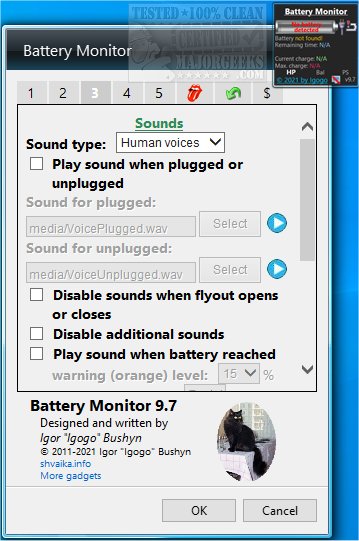The latest version of Battery Monitor, 10.6, offers enhanced features to provide users with comprehensive insights into their battery status. Key details available include voltage, charge rate, current charge, and maximum charge capacity, allowing for better monitoring and management of battery health.
For users operating on Windows 8.1 or 10 who encounter installation difficulties, utilizing Desktop Gadgets Revived or similar applications may be necessary to ensure compatibility with Battery Monitor.
In addition to detailed metrics, Battery Monitor presents visual graphics and animated indicators that signal the current battery level. Users can also receive sound notifications for various battery states, such as when the laptop is plugged in or unplugged, and when it reaches full charge. The application allows for the customization of two critical battery levels, triggering sound alerts for each.
Another convenient feature is the ability to switch the current power plan directly from the main interface, streamlining power management for users. Battery Monitor’s interface can be personalized by adjusting colors and backgrounds, enhancing the user experience while keeping essential battery information readily accessible.
Extended Features and Tips
Beyond its core functionalities, Battery Monitor can be integrated with other utilities for improved battery management. Users may find it beneficial to explore articles on troubleshooting common battery issues, such as laptops that are plugged in but not charging or tutorials on creating notifications for when the battery is fully charged on Windows 10 and 11.
Additionally, understanding how to change power plan settings effectively can further optimize the laptop's performance and battery longevity. Users should also familiarize themselves with how to view their active power plan, ensuring they are utilizing the most efficient settings for their needs.
Overall, Battery Monitor 10.6 stands out as a versatile tool for users looking to enhance their battery management experience, providing both detailed information and customizable options to fit individual preferences
For users operating on Windows 8.1 or 10 who encounter installation difficulties, utilizing Desktop Gadgets Revived or similar applications may be necessary to ensure compatibility with Battery Monitor.
In addition to detailed metrics, Battery Monitor presents visual graphics and animated indicators that signal the current battery level. Users can also receive sound notifications for various battery states, such as when the laptop is plugged in or unplugged, and when it reaches full charge. The application allows for the customization of two critical battery levels, triggering sound alerts for each.
Another convenient feature is the ability to switch the current power plan directly from the main interface, streamlining power management for users. Battery Monitor’s interface can be personalized by adjusting colors and backgrounds, enhancing the user experience while keeping essential battery information readily accessible.
Extended Features and Tips
Beyond its core functionalities, Battery Monitor can be integrated with other utilities for improved battery management. Users may find it beneficial to explore articles on troubleshooting common battery issues, such as laptops that are plugged in but not charging or tutorials on creating notifications for when the battery is fully charged on Windows 10 and 11.
Additionally, understanding how to change power plan settings effectively can further optimize the laptop's performance and battery longevity. Users should also familiarize themselves with how to view their active power plan, ensuring they are utilizing the most efficient settings for their needs.
Overall, Battery Monitor 10.6 stands out as a versatile tool for users looking to enhance their battery management experience, providing both detailed information and customizable options to fit individual preferences
Battery Monitor 10.6 released
Battery Monitor gives you more details about your battery status, including voltage, charge rate, current charge, and max charge.


